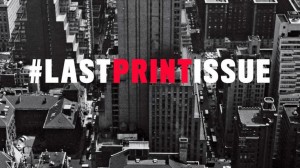By Gadjo Cardenas Sevilla
Newsweek, the weekly global newsmagazine that captured current events and news since 1933 sold its final issue on December 31, 2012, not with a bang but with a hashtag.
With a striking black and white photo of the Newsweek logo on top of the Empire State Building bannered with #LASTPRINTISSUE, alluding to social network Twitter’s use of hashtags to categorize trending messages, Newsweek was one of the most recognizable print publications to go all digital and abandon the traditonal magazine format. The black and white photograph, while stunning, seemed to recall a different time and another world altogether where entities like Time and Newsweek were the fastest source of information.
Newsweek was popular for taking current events, hot topics and capturing the zeitgeist of the world and distilling it into short, easily digestible articles while its cover feature always tried to grasp the biggest story of the week.
Websites and blogs, similarly capture snapshots and hot topics but they can get the news items up within hours instead of a week.
Images and text appear almost magically and they can be viewed on millions of computers, tablets and even smartphones before any magazine article can be written, laid-out, printed, bound and transported across cities and countries.
Even faster than websites and blogs, social media services like Twitter have become both the pulse and barometer of the world’s news and events. With 140 character Tweets blasting through cyberspace at the speed of thought, or at lest way faster than any wire service or event news broadcast can compete.
2012 hasn’t been particularly kind to print publicatiions who are faced with declining subscription rates and steep competition for advertising from online publications and blogs. As a result, many online versions of newspapers and magazine have erected paywalls and hope that customers will be okay with subscribing to online content. In many cases, this is content that customers have been accustomed to get for free.
 Other publications, sensing the futility of charging for content that is readily available elsewhere for free, have tried to create more compelling editorial and shape it to better fit tablets and smartphones which are becoming the most popular way to get news and features. But even this approach has been tricky.
Other publications, sensing the futility of charging for content that is readily available elsewhere for free, have tried to create more compelling editorial and shape it to better fit tablets and smartphones which are becoming the most popular way to get news and features. But even this approach has been tricky.
iPad-exclusive magazine The Daily by Rupert Murdoch’s News Corp., debuted in 2011 eager to cash in on the iPad’s red-hot popularity as a new medium. Using the tablet’s multi-touch interface and multimedia capabilities, The Daily tried to create an immersive daily paper that users automatically downloaded and which had interactive content.
The Daily struggled and lost $30 million yearly despite having 100,000 subscribers. On December 3, 2012, News Corp announced that The Daily would cease operations.
I believe there’s definitely a place for print, for websites and for social media in today’s information landscape as each medium does have benefits and disadvantages. It is up to content creators to innovate in their space and try and find ways to be complementary to one another. As we have learned from Newsweek, the old models no longer work in today’s ever changing landscape.




